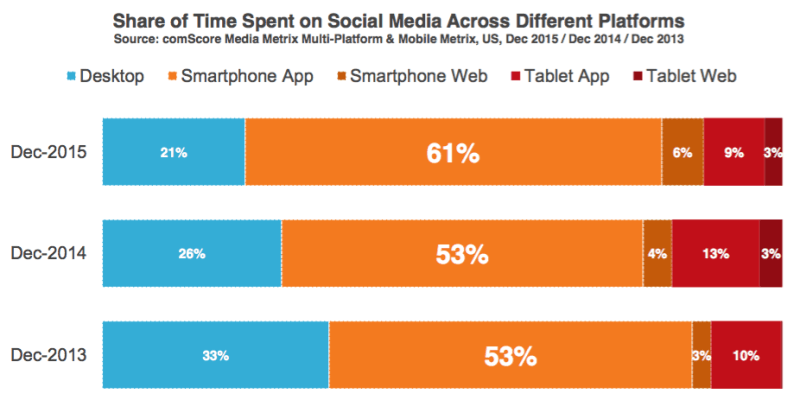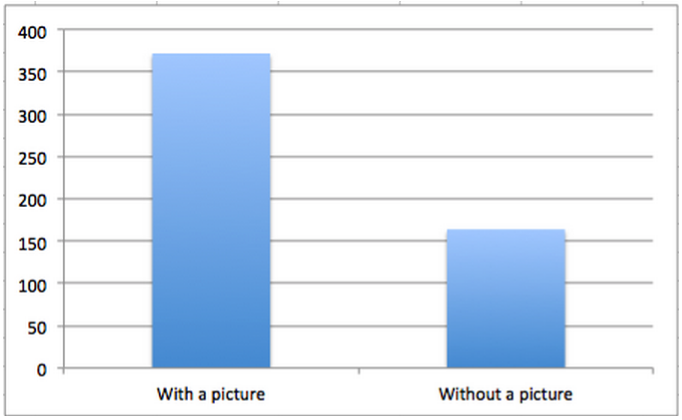We know that social media is a great way to reach people. It's where people ‘hang out' online.
But reach isn't everything. Not even close. What's better than reaching people?
How about getting people to convert.
Meaning turning them into either leads or sales.
A sale is less likely, because people usually aren't on social media looking to buy something. But they are looking to find cool stuff.
That's where you and your content come in.
I found a very interested article about this topic from Social Sprout – check it out:
1. Make Your Landing Pages Mobile First
In a recent study from comScore, 80% of time spent on social media is through a mobile device.
[image source: Sprout Social]
That means a majority of people you’re directing from social media to your landing page view it from a phone or tablet.
When you’re making landing pages to drive social media conversions, you need to think from a mobile-first perspective. That means keeping it more lightweight, sizing your images correctly and streamlining.
2. Keep it Brief
Remember, people on social media aren’t necessarily in “buying mode.”
If you direct them to a 1,500 word sales page or a 20 minute video, they’re likely to click away.
Instead, make your landing pages brief. Also, think in terms of leads rather than sales. Social media users are at the top of your funnel, so the likelihood of converting them into a sale is much lower than getting their email address or having them sign up for a free trial.
3. Split Test Social Media Posts
Before worrying about getting people to convert on your landing page, you need to actually get them to the page. That means optimizing your social media posts. Whether it’s your Tweets, Instagram pictures or Facebook posts, you need to make sure they’re compelling people to click through.
One of the best ways to do this is through split testing. Create variations of the same Tweets or try Instagram posts with different captions or images.
You can use Sprout Social to quickly schedule multiple versions of your social media posts and compare each version against each other.
Along with testing your social media content, also test different days and times.
4. Create Network Specific Landing Pages
Have you ever heard of account-based marketing? It’s basically a fancier way of saying personalization. According to Insightera, account-based marketing can result in four times more traffic.
The challenge is figuring out a way to provide a personalized experience for people visiting your landing page from social media.
For instance, if you’re directing people to your landing page from Twitter, you could personalize it by using a light color scheme similar to Twitter’s or creatively integrate Tweets. Making the transition from the social network to your landing page as smooth as possible will improve your chances of converting users.
5. Use Better Images
Images are a huge piece of social media marketing. In fact, Facebook posts with images get 2.3X more engagement than those without them. That’s likely why 71% of digital marketers use visuals in their social media marketing.
[image source: Sprout Social]
Remember, your copy is only part of the equation when it comes to getting people to click your Tweets or Facebook posts. Without an attention grabbing image, there’s a chance people are scrolling right pass your social media content. Thousands of Tweets are sent every second, and over 95 million Instagram posts are uploaded every day. Your content is competing with all of that content for the attention of social media users. Your images can help you stand out.
So what type of images can you use to capture your audience’s eye? Here are some best practices for using images to boost your social media conversion rate:
- Use faces for Instagram: According to a study conducted by Georgia Institute of Technology, Instagram posts with faces get 38% more Likes than those without them.
- Use large summary cards for Twitter: BuzzSumo found that Tweets with large summary Twitter cards receive 3 times more interactions.
- Create network-specific images: You can consider creating images specifically for driving social media conversions, rather than just using the image Twitter or Facebook pulls from your website. This is a good idea for companies that tend to use stock images as their featured images. Creating custom graphics with vibrant colors or even a call to action can be much more engaging.
- Don’t use too much text: Your visuals shouldn’t be overrun with text. That’s part of the reason Facebook implemented it’s 20% text rule for ads. Save the text for your headlines or Instagram captions.
You can read more at Sprout Social.
CHALLENGE Yourself to Profit!
Free Download: Build Your Profit-Generating Online Business With This Free Blueprint
Sign Up, follow the easy steps and You'll get the tactics, strategies & techniques needed to create your online profit stream. It's free!





